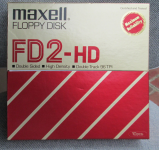daver2
10k Member
There is the PDP11 source code somewhere for the bootstrap...
Ah, Radix has found the full version...
Dave
Ah, Radix has found the full version...
Dave
Just to ensure things are clear, there are only two types of media above: single-sided and double-sided. "Single density" and "double density" recordings are both done on the same media; the difference is in the signal sent to the drive (FM vs. MFM); standard density media will record both equally well. (This doesn't stop manufacturers from marking their media "double density," of course, but such a marking is meaningless except insofar as it means the media isn't high density.)The following designations and products were common
- SSSD => Single-Sided Single-Density (RX01)
- SSDD => Single-Sided Double-Density (RX02)
- DSSD => Double-Sided Single-Density
- DSDD => Double-Sided Double-Density
You call them the same thing that you call them if you don't have that rig, since the Future Data system does not magically transform the diskettes you put into it into something else, or re-coat the inserted media, or anything like that....and of course, if you've got a rig that uses 8" GCR (e.g. Future Data), nobody knows what to call the disks.
I'm not aware of any special "high density" formulation for 8" floppies--basically, it's all a matter of holes; viz, single-sided, double-sided, flippy, or hard-sectored (with the exception of the Memorex 650 type, all 32 hard sectors). Even Wang 8" so-called 16 hard sector floppies have 33 holes, with the hardware dividing the sector pulses.I use the term "standard density," as the only other actually different media (as in, a different coating on the surface) that was ever in remotely common use is High Density.
There was one. It was rare, but it existed and was commercially sold by Maxell, at least.I'm not aware of any special "high density" formulation for 8" floppies...

Ah, that's interesting to know!8" drives with hard sector discrimination circuitry (e.g. Siemens FDD-200) can use hard-sectored floppies as soft-sectored ones, as the sector pulse is assigned to a different pin from the index.
